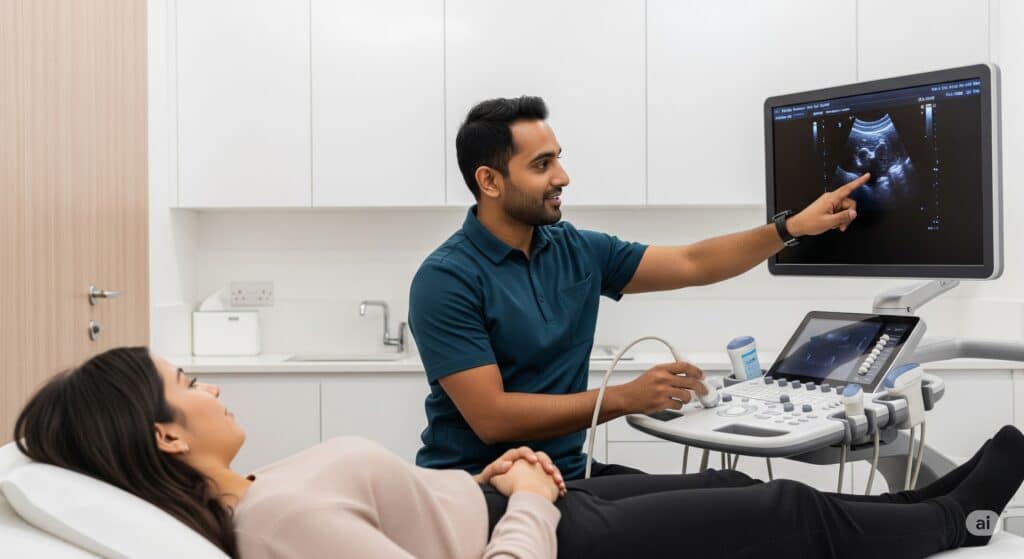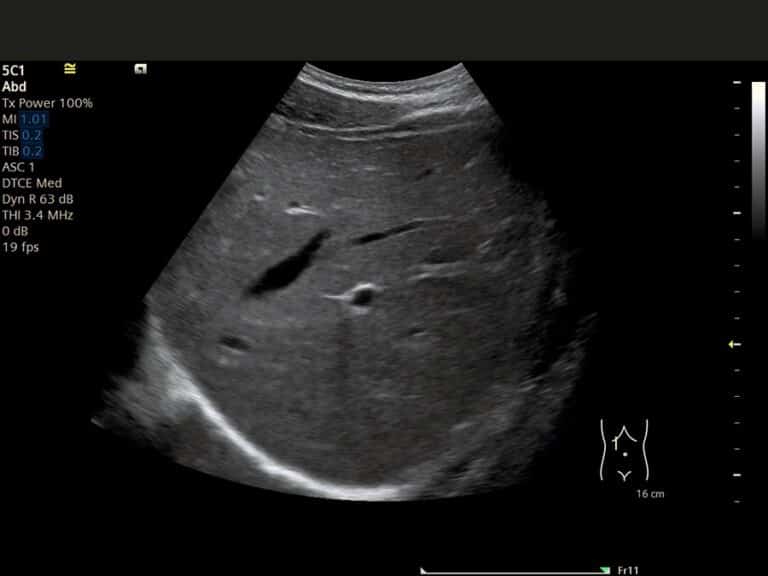After twenty years of practicing ultrasound imaging across London's NHS trusts and private clinics, I have witnessed first-hand the evolving landscape of abdominal health in our diverse capital. From the busy emergency departments of King's College Hospital to the quiet consultation rooms of Harley Street, the patterns of abdominal pathology I encounter daily tell a compelling story about London's unique health challenges.
London's eight million residents present a complex tapestry of health conditions that reflect both our city's remarkable diversity and its particular environmental pressures.
The patients who walk through our doors carry with them the health impacts of urban living, cultural dietary patterns, occupational stresses, and the socioeconomic realities of life in one of the world's most expensive cities.

Why Our City's Abdominal Health Patterns Are Unique
Working across both NHS and private healthcare settings has given me an unparalleled view of how London's demographics shape the abdominal conditions we diagnose. The capital's population includes significant communities from South Asia, Africa, the Caribbean, and Eastern Europe, each bringing distinct genetic predispositions and cultural health practices that influence the conditions we detect through abdominal ultrasound.
London's air quality presents another layer of complexity. Research from Queen Mary University of London has demonstrated clear links between the capital's pollution levels and various health outcomes, including inflammatory conditions that affect abdominal organs. The particulate matter from our busy roads and construction sites doesn't just affect respiratory health – it creates systemic inflammation that can impact liver function, gallbladder health, and digestive processes.
The stress of London living cannot be understated. Housing costs that consume 40-50% of household income, lengthy commutes on overcrowded transport, and the relentless pace of city life create chronic stress patterns that manifest in our abdominal imaging. Stress-related conditions, from functional gallbladder disorders to inflammatory bowel conditions, appear with striking frequency in our London patient population.
Fatty Liver Disease: London's Silent Epidemic
Perhaps no condition better illustrates London's unique health challenges than non-alcoholic fatty liver disease (NAFLD). The British Liver Trust estimates that fatty liver disease affects one in five people across the UK, but my experience suggests the prevalence in London may be even higher, particularly among certain ethnic communities.
South Asian patients, who comprise a significant portion of London's population, show dramatically higher rates of fatty liver disease than their white British counterparts. This disparity reflects both genetic predisposition and the complex interplay of diet, lifestyle, and metabolic factors. The traditional South Asian diet, while rich in vegetables and legumes, often includes high levels of refined carbohydrates and cooking oils that, when combined with London's sedentary lifestyle patterns, contribute to hepatic steatosis.
During my years at various London NHS trusts, I have observed that South Asian patients often present with fatty liver disease at younger ages and lower body weights than typically seen in other populations. A 35-year-old software engineer from Southall might show significant hepatic steatosis despite having a BMI within normal range – a pattern that would be unusual in other demographic groups but has become increasingly common in my London practice.
The ultrasound scan appearance of fatty liver disease has become so familiar that I can often predict the diagnosis before completing the examination. The liver appears brighter than normal on ultrasound, with increased echogenicity that creates a characteristic "bright liver" appearance. The contrast between the liver and kidney becomes more pronounced, and in advanced cases, the deeper portions of the liver become difficult to visualize due to increased attenuation of the ultrasound beam.
Black African and Caribbean communities in London present their own patterns of liver disease. While fatty liver disease occurs in these populations, I have observed higher rates of viral hepatitis and its complications. The complex immigration patterns that have shaped London's demographics mean that many patients carry hepatitis B or C infections acquired in their countries of origin, often remaining undiagnosed for years until routine ultrasound screening reveals chronic liver changes.
The economic implications of fatty liver disease in London are staggering. NHS England data shows that liver disease admissions have increased by over 400% in the past two decades, with London hospitals bearing a disproportionate burden. The progression from simple fatty liver to non-alcoholic steatohepatitis (NASH) and eventually to cirrhosis represents a healthcare time bomb that ultrasound imaging helps us identify and monitor.
Gallbladder Disease
Gallbladder disease represents another area where London's unique demographics create distinct patterns of pathology. The traditional risk factors – female gender, age over 40, obesity, and pregnancy – remain relevant, but London's diverse population adds layers of complexity that require nuanced understanding.
Turkish and Middle Eastern communities in North London show particularly high rates of gallstone disease, reflecting both genetic predisposition and dietary patterns rich in saturated fats. The traditional Turkish breakfast, while culturally important, often includes high levels of cheese, processed meats, and fried foods that contribute to cholesterol gallstone formation. I have seen entire families affected by gallbladder disease, with mothers, daughters, and sisters all requiring treatment within short timeframes.
The ultrasound detection of gallstones has become routine in my NHS and private ultrasound practice, but the clinical significance varies dramatically based on patient demographics and presentation. A 45-year-old Turkish woman presenting with right upper quadrant pain will almost certainly have gallstones visible on ultrasound, while a similar presentation in a young Chinese woman might suggest entirely different pathology.
London's work culture contributes significantly to gallbladder disease patterns. The city's long working hours and irregular meal patterns create perfect conditions for gallbladder dysfunction. Financial sector workers in Canary Wharf, healthcare professionals working rotating shifts, and restaurant workers in London's hospitality industry all show elevated rates of gallbladder problems related to irregular eating patterns and high stress levels.
The seasonal variation in gallbladder disease admissions across London hospitals reflects both dietary patterns and healthcare-seeking behaviour. December and January see spikes in gallbladder-related emergency admissions, likely related to holiday dietary indiscretions combined with delayed healthcare seeking during the festive period.
Kidney Disease
Kidney disease detection through ultrasound reveals another dimension of London's health disparities. Black African and Caribbean communities show dramatically higher rates of chronic kidney disease, with hypertensive nephropathy being particularly common. The ultrasound appearances of chronic kidney disease – small, echogenic kidneys with poor corticomedullary differentiation – have become tragically familiar in my practice when examining patients from these communities.
The relationship between London's air pollution and kidney health represents an emerging area of concern. Research published in the British Medical Journal has demonstrated associations between particulate matter exposure and declining kidney function. Living near major London roads like the A40 or M25 appears to accelerate kidney disease progression, particularly in patients with existing risk factors like diabetes or hypertension.
South Asian patients present unique challenges in kidney disease detection. The high prevalence of diabetes in these communities, combined with cultural dietary patterns and genetic predisposition, creates a perfect storm for diabetic nephropathy. I have observed that South Asian patients often present with more advanced kidney disease at diagnosis, possibly reflecting delayed healthcare seeking or inadequate screening in primary care.
The ultrasound evaluation of kidney disease requires careful attention to both structural and functional indicators. Kidney size, echogenicity, corticomedullary differentiation, and the presence of cysts or stones all provide important diagnostic information. In London's diverse population, normal kidney size varies significantly between ethnic groups, requiring adjusted reference ranges for accurate interpretation.
Polycystic kidney disease shows interesting patterns across London's ethnic communities. While the autosomal dominant form affects all populations equally, I have observed clustering of cases within certain families and communities, likely reflecting both genetic factors and improved diagnostic awareness within affected families.
Pancreatic Conditions: The Hidden Challenges of London Living
The pancreas, often called the "hidden organ" due to its deep abdominal location, presents unique diagnostic challenges that are amplified by London's demographic and lifestyle patterns. Pancreatic pathology in London patients reflects the complex interplay of genetic predisposition, environmental factors, and the stresses of urban living.
Acute pancreatitis admissions across London hospitals show distinct seasonal and demographic patterns. The Christmas and New Year period consistently brings a surge of alcohol-related pancreatitis cases, particularly affecting middle-aged professionals who combine high-stress careers with social drinking patterns. The ultrasound appearances of acute pancreatitis – pancreatic swelling, peripancreatic fluid collections, and gallbladder wall thickening – have become increasingly familiar during these peak periods.
South Asian communities in London face particular challenges with pancreatic health. Research published in the British Journal of Surgery has demonstrated that South Asian patients develop acute pancreatitis at younger ages and with more severe complications than other ethnic groups. The combination of genetic predisposition, high triglyceride levels, and gallstone disease creates a perfect storm for pancreatic inflammation.
Chronic pancreatitis presents differently across London's diverse population. Alcohol-related chronic pancreatitis remains common among certain demographic groups, but I have observed increasing numbers of cases related to autoimmune conditions and genetic factors. The ultrasound features of chronic pancreatitis – pancreatic atrophy, ductal dilatation, and calcifications – often develop insidiously over years before becoming clinically apparent.
Type 2 diabetes rates in London vary dramatically by ethnicity, with South Asian and Black African communities showing prevalence rates three to four times higher than white British populations. This disparity directly impacts pancreatic health, as diabetes both results from and contributes to pancreatic dysfunction. The ultrasound evaluation of diabetic patients often reveals pancreatic atrophy and fatty infiltration, reflecting the long-term metabolic stress on this vital organ.
Pancreatic cancer, while relatively uncommon, shows concerning trends in London's population. The disease affects South Asian communities disproportionately, often presenting at younger ages than typically seen in other populations. The ultrasound detection of pancreatic masses requires exceptional skill and experience, as early-stage tumors can be subtle and easily missed. My years of practice have taught me to pay particular attention to indirect signs – pancreatic duct dilatation, bile duct obstruction, and changes in pancreatic echogenicity – that might indicate underlying malignancy.
Inflammatory Bowel Disease: London's Changing Demographics
Inflammatory bowel disease (IBD) patterns in London reflect both the city's diverse population and changing environmental factors. Research from Imperial College London has demonstrated significant ethnic differences in IBD presentation, with South Asian patients showing higher rates of ulcerative colitis compared to Crohn's disease.
The ultrasound evaluation of IBD has evolved significantly during my career. While endoscopy remains the gold standard for diagnosis, ultrasound provides valuable information about bowel wall thickness, vascularity, and complications such as abscesses or strictures. The technique requires specialized training and experience, but can provide immediate diagnostic information in emergency settings.
London's air pollution appears to influence IBD patterns, with research suggesting that particulate matter exposure may trigger inflammatory responses in genetically susceptible individuals. Patients living in high-pollution areas of London, particularly near major roads or industrial sites, show more frequent IBD flares and complications.
The stress of London living undoubtedly impacts IBD management. The city's fast-paced lifestyle, irregular meal patterns, and high stress levels all contribute to disease flares. I have observed that IBD patients working in high-stress London industries – finance, law, healthcare – often struggle with disease management despite optimal medical therapy.
Cultural dietary patterns add another layer of complexity to IBD management in London. Traditional South Asian diets, rich in spices and fiber, can be both beneficial and problematic for IBD patients. The challenge lies in maintaining cultural food practices while managing inflammatory bowel conditions.
Abdominal Aortic Aneurysms: Age, Ethnicity, and Urban Risk Factors
Abdominal aortic aneurysm (AAA) screening represents one of the most successful preventive health programs in London, but the results reveal striking demographic disparities. The NHS AAA screening program, which targets men aged 65 and over, has identified significant variations in aneurysm prevalence across London's ethnic communities.
White British men show the highest rates of AAA, reflecting both genetic predisposition and lifestyle factors including smoking and hypertension. The ultrasound detection of AAA requires careful measurement of the aortic diameter at multiple levels, with particular attention to the maximum diameter and the presence of mural thrombus.
South Asian men show lower rates of AAA despite higher rates of cardiovascular disease, suggesting protective genetic factors. However, when AAA does occur in this population, it often presents with more rapid expansion and earlier rupture risk, requiring more aggressive monitoring and intervention.
The relationship between London's air pollution and cardiovascular disease extends to AAA development and progression. Research has demonstrated associations between particulate matter exposure and accelerated atherosclerosis, which directly contributes to aneurysm formation and expansion.
Smoking cessation programs in London have had variable success across different communities, with cultural and socioeconomic factors influencing uptake and effectiveness. The impact on AAA prevention has been dramatic in some areas, with significant reductions in new aneurysm formation among former smokers.
Hepatitis and Liver Disease: London's Global Health Challenges
London's status as a global city brings unique challenges in hepatitis management and liver disease prevention. The city's diverse immigrant population includes many individuals from regions with high hepatitis B and C prevalence, creating complex patterns of chronic liver disease.
Hepatitis B prevalence varies dramatically across London's ethnic communities. Sub-Saharan African communities show particularly high rates, often with vertical transmission from mother to child. The ultrasound appearances of chronic hepatitis B – liver surface irregularity, splenomegaly, and portal hypertension – develop gradually over decades, often remaining asymptomatic until advanced stages.
Chinese communities in London face particular challenges with hepatitis B, as the infection is often acquired in childhood and remains undiagnosed for years. The cultural stigma associated with hepatitis in some communities can delay diagnosis and treatment, leading to more advanced liver disease at presentation.
Hepatitis C patterns reflect London's complex social demographics. While injection drug use remains a significant risk factor, many cases result from medical procedures performed in countries with less stringent infection control practices. The ultrasound evaluation of hepatitis C patients requires careful assessment for signs of cirrhosis and portal hypertension.
The introduction of direct-acting antiviral therapy for hepatitis C has revolutionized treatment outcomes, but access remains challenging for some London communities. Language barriers, immigration status concerns, and cultural factors all influence treatment uptake and adherence.
Spleen Disorders: Infections, Blood Disorders, and Cultural Health Practices
Spleen pathology in London patients reflects both infectious diseases and haematological conditions that vary significantly across ethnic communities. The ultrasound evaluation of spleen size and echogenicity provides important diagnostic information, but normal values vary considerably between ethnic groups.
Sickle cell disease, predominantly affecting Black African and Caribbean communities, creates characteristic spleen changes visible on ultrasound. The repeated vaso-occlusive crises lead to splenic infarction and eventual auto-splenectomy, with the spleen becoming small and fibrotic over time.
Thalassemia, common in Mediterranean, Middle Eastern, and South Asian communities, causes splenomegaly due to increased red blood cell destruction. The ultrasound appearances can be dramatic, with massive spleen enlargement that may require surgical intervention.
Malaria remains a consideration in London patients with recent travel to endemic areas. The acute splenic changes associated with malaria – splenomegaly and altered echogenicity – can be detected on ultrasound, though the diagnosis requires clinical correlation and laboratory confirmation.
Cultural health practices sometimes influence spleen pathology. Traditional medicines used in some communities can cause hepatotoxicity and secondary spleen changes, requiring careful history-taking and cultural sensitivity in evaluation.
The Impact of London's Healthcare System on Diagnostic Patterns
Working across both NHS and private healthcare settings has provided unique insights into how healthcare access influences diagnostic patterns and patient outcomes. The "postcode lottery" of healthcare access across London's boroughs creates significant disparities in early detection and management of abdominal conditions.
NHS ultrasound services face significant capacity constraints, with waiting times varying dramatically across London trusts. Emergency departments rely heavily on ultrasound for rapid diagnosis, but the pressure to maintain throughput can sometimes compromise diagnostic accuracy. The skill mix of operators – from consultant radiologists to emergency medicine physicians – creates variability in diagnostic quality.
Private healthcare in London offers immediate access to ultrasound services, but the patient population differs significantly from NHS patients. Private patients tend to be younger, more affluent, and more likely to seek screening rather than diagnostic imaging. This creates different patterns of pathology detection and management.
The integration between NHS and private healthcare in London creates unique opportunities for comprehensive care. Many consultants work across both sectors, providing continuity of expertise and ensuring that complex cases receive appropriate management regardless of funding source.
Language barriers significantly impact ultrasound examinations across London's diverse population. The need for interpretation services, cultural sensitivity in examination techniques, and understanding of different health beliefs all influence diagnostic accuracy and patient experience.
Clinical Insights: Lessons from Two Decades of Practice
The evolution of ultrasound technology during my twenty-year career has been remarkable, but the fundamental principles of patient care remain unchanged. Each examination tells a story that extends far beyond the images on the screen, encompassing the patient's cultural background, socioeconomic circumstances, and the complex health challenges of London living.
Pattern recognition becomes increasingly sophisticated with experience. A 55-year-old Bangladeshi taxi driver presenting with right upper quadrant pain will almost certainly have gallstones, but the clinical significance depends on numerous factors including diabetes status, family history, and previous episodes. The ultrasound examination must be tailored to answer specific clinical questions while remaining sensitive to cultural considerations.
The importance of clinical correlation cannot be overstated. Ultrasound findings must always be interpreted within the broader clinical context, particularly in London's diverse population where normal variants and disease patterns may differ from textbook descriptions. A mildly enlarged spleen in a patient from a malaria-endemic region requires different interpretation than the same finding in a lifelong London resident.
Communication skills become paramount when working with London's multicultural population. Explaining ultrasound findings through interpreters, respecting cultural modesty requirements, and understanding different health beliefs all influence the success of the examination and subsequent patient care.
The psychological impact of ultrasound examinations varies significantly across cultural groups. Some patients view ultrasound as routine and reassuring, while others may have significant anxiety about the procedure or its implications. Understanding these cultural differences improves patient experience and diagnostic accuracy.
Practical Recommendations for Patients
Understanding when to seek ultrasound evaluation can help London residents access appropriate care promptly. Persistent abdominal pain, unexplained weight loss, changes in bowel habits, and family history of abdominal conditions all warrant consideration of ultrasound examination.
Preparation for ultrasound examinations varies depending on the specific study required. Fasting may be necessary for gallbladder or pancreatic evaluation, while a full bladder improves visualization of pelvic organs. Clear instructions from healthcare providers ensure optimal examination quality.
Cultural and religious considerations should be discussed with healthcare providers before ultrasound examinations. Most London hospitals can accommodate modesty requirements and provide same-gender operators when requested.
Follow-up arrangements after ultrasound examinations are crucial for optimal patient care. Understanding when and how results will be communicated, what additional tests might be needed, and when to seek urgent medical attention ensures appropriate care continuity.
The NHS vs. Private Experience
Having worked extensively in both sectors, I have the utmost respect for my NHS colleagues. They do incredible work under immense pressure. However, the patient journey is different.
In the NHS, you'll need a GP referral for a routine scan, and the waiting list can, unfortunately, be several weeks or even months. For a worried patient, that waiting period is filled with anxiety.
This is where private healthcare offers a vital alternative. Here at International Ultrasound Services, you can self-refer. You can call us with a concern and often get an appointment the same or the next day. We have the luxury of time – time to perform a thorough scan, and crucially, time to sit with you, show you the images, and explain the findings in a way you can understand. You leave with a report in your hand and a clear path forward.
Content Information
We review all clinical content annually to ensure accuracy. If you notice any outdated information, please contact us at info@iuslondon.co.uk.
About the Author:

Yianni is a highly experienced sonographer with over 21 years in diagnostic imaging. He holds a Postgraduate Certificate in Medical Ultrasound from London South Bank University and is registered with the Health and Care Professions Council (HCPC: RA38415). Currently working at Barts Health NHS Trust, Yianni specialises in abdominal, gynaecological, and obstetric ultrasound. He is a member of the British Medical Ultrasound Society (BMUS), Society of Radiographers (SoR) and regularly contributes to sonographer and junior radiologists training programs.



